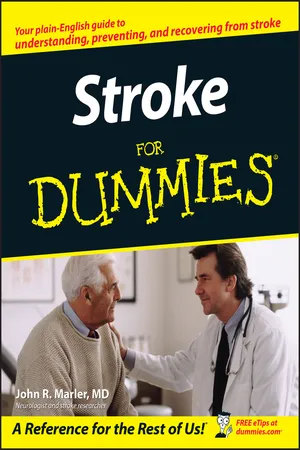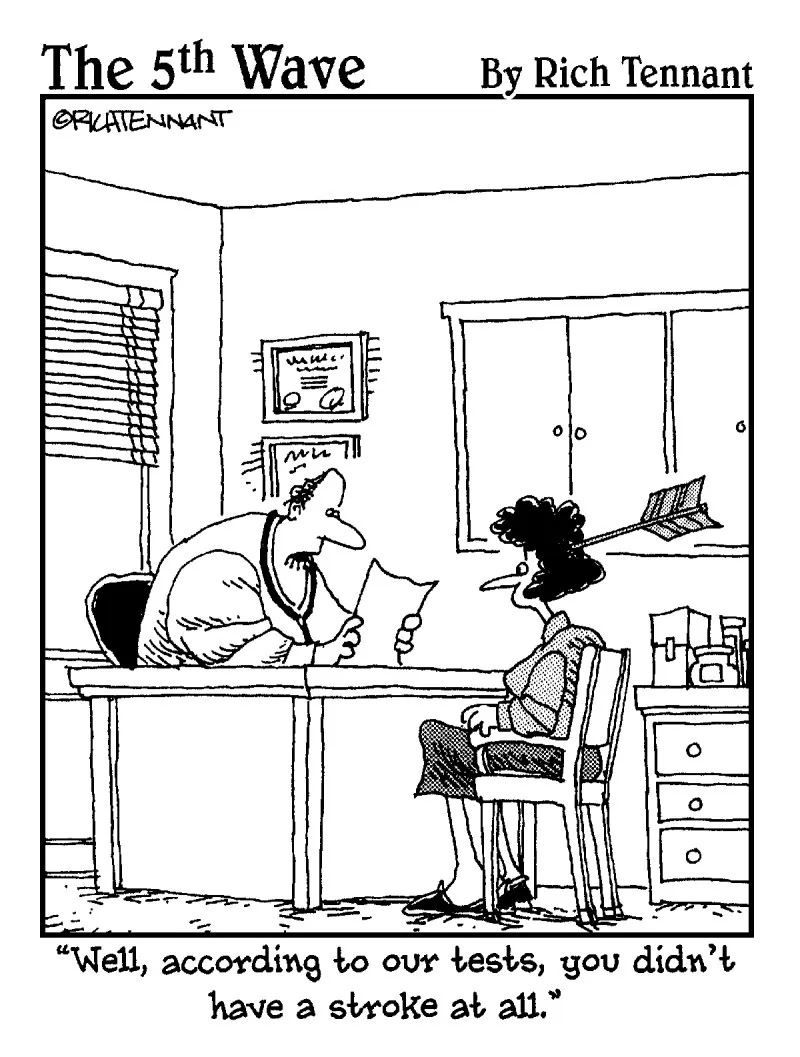
eBook - ePub
Stroke For Dummies
John R. Marler
This is a test
- English
- ePUB (adapté aux mobiles)
- Disponible sur iOS et Android
eBook - ePub
Stroke For Dummies
John R. Marler
Détails du livre
Aperçu du livre
Table des matières
Citations
À propos de ce livre
Features tons of advice for recovery and rehabilitation
Get the latest on the symptoms, diagnosis, and treatment of stroke
Have questions and concerns about strokes? This reassuring guide provides invaluable information for stroke victims and their loved ones, from what a stroke is and what it feels like to proven treatments and therapies. You'll see how to implement a plan for preventing stroke, treat the lingering effects of stroke, and maximize home caregiver effectiveness while minimizing fatigue.
Discover how to:
- Understand what causes different types of stroke
- Recognize warning signs
- Get the most out of doctors and hospitals
- Speed recovery with the best treatments
- Help prevent future strokes
- Decide the best living arrangements after stroke
Foire aux questions
Comment puis-je résilier mon abonnement ?
Il vous suffit de vous rendre dans la section compte dans paramètres et de cliquer sur « Résilier l’abonnement ». C’est aussi simple que cela ! Une fois que vous aurez résilié votre abonnement, il restera actif pour le reste de la période pour laquelle vous avez payé. Découvrez-en plus ici.
Puis-je / comment puis-je télécharger des livres ?
Pour le moment, tous nos livres en format ePub adaptés aux mobiles peuvent être téléchargés via l’application. La plupart de nos PDF sont également disponibles en téléchargement et les autres seront téléchargeables très prochainement. Découvrez-en plus ici.
Quelle est la différence entre les formules tarifaires ?
Les deux abonnements vous donnent un accès complet à la bibliothèque et à toutes les fonctionnalités de Perlego. Les seules différences sont les tarifs ainsi que la période d’abonnement : avec l’abonnement annuel, vous économiserez environ 30 % par rapport à 12 mois d’abonnement mensuel.
Qu’est-ce que Perlego ?
Nous sommes un service d’abonnement à des ouvrages universitaires en ligne, où vous pouvez accéder à toute une bibliothèque pour un prix inférieur à celui d’un seul livre par mois. Avec plus d’un million de livres sur plus de 1 000 sujets, nous avons ce qu’il vous faut ! Découvrez-en plus ici.
Prenez-vous en charge la synthèse vocale ?
Recherchez le symbole Écouter sur votre prochain livre pour voir si vous pouvez l’écouter. L’outil Écouter lit le texte à haute voix pour vous, en surlignant le passage qui est en cours de lecture. Vous pouvez le mettre sur pause, l’accélérer ou le ralentir. Découvrez-en plus ici.
Est-ce que Stroke For Dummies est un PDF/ePUB en ligne ?
Oui, vous pouvez accéder à Stroke For Dummies par John R. Marler en format PDF et/ou ePUB ainsi qu’à d’autres livres populaires dans Medicine et Diseases & Allergies. Nous disposons de plus d’un million d’ouvrages à découvrir dans notre catalogue.
Informations
Part I
The Brain and Stroke

In this part . . .
**IN a DROPCAP**
W hat is stroke, what does it do to the brain — and how and why does it do this? These are a few of the questions I tackle in this part. I begin in Chapter 1 by describing the process and mechanisms of the different kinds of stroke. Chapter 2 covers the basics of how the brain does what it does and how stroke disrupts its natural workings.
Chapter 1
A Brain Attack
In This Chapter





L et me hit you with the bad news first: Stroke kills, stroke destroys, stroke debilitates. Stroke is the third most common cause of death in the United States, and the number-one cause of serious disability. One year after the most common kind of stroke, approximately 30 percent of those afflicted will have died, and another 30 percent will have a moderate to severe disability.
Now for some good news: Of those who experience the most common type of stroke, approximately 40 percent are left with only a mild or no disability one year later. And each year more people survive and recover from stroke as medical research continues to advance effective treatment. Today, recovery with improvement is the rule rather than the exception.
Stroke is sometimes called a brain attack. I wish this label would catch on, because I think that people might then understand that stroke is an emergency — like a heart attack — and call 911 right away! A heart attack threatens your heart; a stroke threatens your brain. In truth, most stroke is like a heart attack: It’s a problem with blood vessels, and time is really important. However, heart attack is a little easier to recognize. First of all, the pain tells you something is wrong — and it is usually near your heart. Most strokes are painless, and the symptoms, a paralyzed arm or leg for instance, are not obviously related to the brain.
Clearly, the more you know about stroke — its symptoms, causes, risks, treatment, and prevention — the better your chances of living a full and productive life with or, better yet, without stroke. And the first lesson is to learn what stroke is and how and why stroke occurs.
If you’ve already had a stroke, there are many opportunities to reduce the disability that stroke causes and prevent another stroke attack. A serious stroke will affect your entire family. You can fight back together.
-plgo-compressed.webp)
Real-life examples
A 57-year-old man arrives early at work to prepare for an important presentation he has to make at 10 a.m. At about 9:15 he notices a headache. He thinks this is unusual, because he doesn’t have many headaches. He remembers that he did forget his blood pressure medication. He continues to work for a few minutes and then notices his right hand is not working and he can’t concentrate. He calls for his assistant who finds him looking very unusual. His mouth is twisted. He starts to talk but his speech is difficult to understand. She asks if he is okay. He says no. He starts to get up but his right arm gives way and he almost falls. His assistant calls 911.
A 68-year-old woman is preparing breakfast for herself and her husband. He has made the coffee and is reading the newspaper. He hears her drop a plate and looks up to see her standing and looking at her left hand. He asks her what’s wrong. She says she doesn’t know. Her face — particularly the way she is holding her mouth — looks unusual. She keeps looking at her hand. “My hand is numb,” she says. He asks her to sit down. She seems confused as he leads her to a chair. He asks if it hurts. She says no. “I think you’re having a stroke,” he says. He dials 911.
A 38-year-old lawyer is out jogging on a canal towpath. She starts to feel pain in her head that gets worse and worse. She stops, puts her hand to her head, and falls to the ground. A man walking ahead of her sees her fall. He runs to her but she is unconscious. He pulls out his cellphone and dials 911.
Attacking Out of the Blue
Stroke is nothing if not fast. Each year, as many as 750,000 people in the United States suffer a sudden and unexpected attack of the brain. When part of the brain is deprived of oxygen — which is what is happening when stroke hits — it doesn’t take long for the catastrophe to make itself evident. A minute or less.
Whether it’s a sudden inability to speak, the crash of a dish from a hand that can no longer grasp, or loss of consciousness, a brain attack strikes its victims quickly and powerfully and without warning.
Or does it? Although your stroke may occur in a lightning flash, it has most likely been years in the making, with conditions such as high blood pressure, high cholesterol, obesity, and diabetes possibly serving as warning signs that the brain is in danger. Basically, as these conditions cause wear and tear on your blood vessels, your risks increase of suffering either a blockage or rupture of a brain artery. And — suddenly — you’re in stroke mode.
So how does it happen? It starts with the brain.